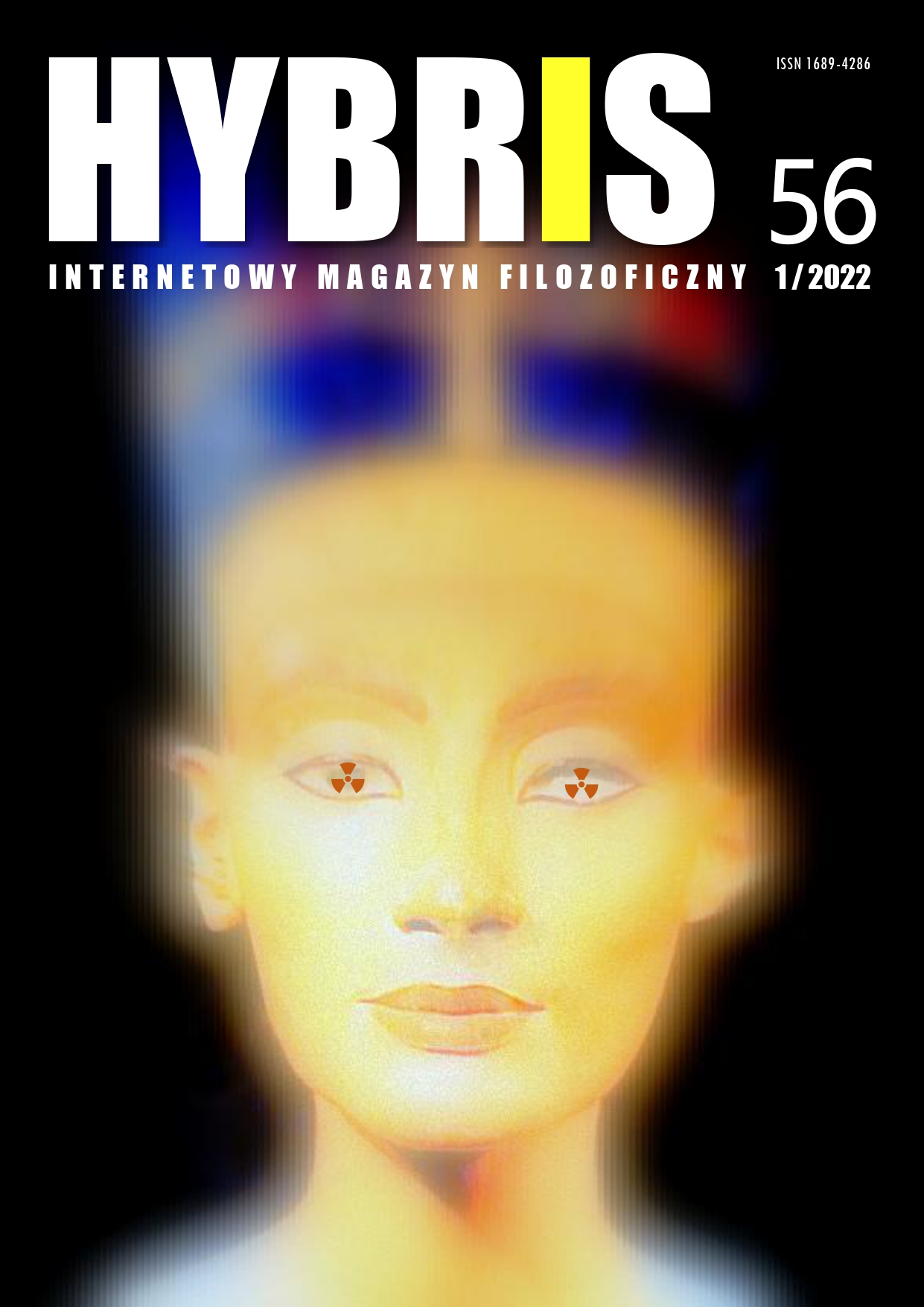“Hieroglifes of the Anthropocene”. "Casus" of the Work of Lech Majewski
DOI:
https://doi.org/10.18778/1689-4286.56.05Keywords:
anthropocentrism, human versus nature, film, Lech MajewskiAbstract
The subject of the text is the analysis of the anthropocene valuation in cultural texts (film), both literally and metaphorically, and its representation on the example of selected films by Lech Majewski (born 1953).
The main purpose of the considerations is to show the synergy of man with his environment (see environmental humanities), in the indicated creativity, in the semiotic and cultural aspect. This allows us to better understand the attitude of the author of Valley of the Gods (2019) towards the transformation of the 21st century.
Methodology: film studies, cultural anthropology
References
Bińczyk E. (2018). Epoka człowieka. Retoryka i marazm antropocenu, Warszawa: PWN.
View in Google Scholar
Bogusławski M. M. (2020). Wariacje (post)humanistyczne, Łódź: Wydawnictwo UŁ. https://doi.org/10.18778/8142-653-4
View in Google Scholar
Braidotti R. (2014). Po człowieku. Przekł. Joanna Bednarek, Agnieszka Kowalczyk, Warszawa: Wydawnictwo PWN.
View in Google Scholar
Domańska E. (2008). Humanistyka nie-antropocentryczna a studia nad rzeczami, Kultura Współczesna, 3, 9-21.
View in Google Scholar
Domańska E., Olsen B. (2008). Wszyscy jesteśmy konstruktywistami. W: Rzeczy i ludzie. Humanistyka wobec materialności. J. Kowalewski, W. Piasek (red.). Olsztyn: Wydawnictwo UWM.
View in Google Scholar
Domańska E. (2017). Sprawiedliwość epistemiczna w humanistyce zaangażowanej, Teksty Drugie, 1, 41-59. https://doi.org/10.18318/td.2017.1.3
View in Google Scholar
Fiedorczuk J. (2015). Cyborg w ogrodzie. Wprowadzenie do ekokrytyki. Gdańsk: Wydawnictwo Naukowe „Katedra”.
View in Google Scholar
Grodź I. (2020). Człowiek i natura. Kilka uwag o "Pokoju saren" Lecha Majewskiego (1997), Rocznik Towarzystwa Naukowego Płockiego, 12, 89-111.
View in Google Scholar
Latour B. (2013). Technologia jako utrwalone społeczeństwo. Przeł. Łukasz Afeltowicz, Avant, 1, 17-48.
View in Google Scholar
Latour B. (2014). Antropology at the Time of the Antropocene – a Personal View of What is to Be Studied, http://www.bruno-latour.fr/sites/default/files/139-AAA-Washington.pdf (dostęp: 06.05.2022).
View in Google Scholar
Lebecka M. (2007). Szklane usta (rec.). Kino, 4, 72.
View in Google Scholar
Lee L. L. (2020). Diné Identity in a Twenty-First-Century World. Arizona: The University of Arizona Press. https://doi.org/10.2307/j.ctv11sn6g4
View in Google Scholar
Majewski L. (1998), Oficjalne centrum świata, Gdańsk: Wydawnictwo „Słowo/ Obraz/Terytoria”.
View in Google Scholar
Majewski L. (2017). Pejzaż intymny. Rozmowy autobiograficzne o świecie i o sztuce, Poznań: Wydawnictwo „Rebis”.
View in Google Scholar
Majewski L. (2020), Ukryty język symboli, Poznań: Wydawnictwo „Rebis”.
View in Google Scholar
Meza E. (2019). Lech Majewski o „Dolinie Bogów”. Variety, https://variety.com/2019/film/festivals/camerimage-lech-majewski-valley-of-the-gods-josh-hartnett-keir-dullea-1203407095/ (dostęp: 06.05.2022).
View in Google Scholar
Muzeum antropocenu. 2021. Kultura Współczesna, 1 (cały numer poświęcony tej tematyce).
View in Google Scholar
Nahlik M. (2009). Archetypy, instynkty, atawizmy i uczucia. W: Ciało i seksualność w polskim kinie. S. Jagielski, A. Morstin-Popławska (red.), Kraków; Wydawnictwo „Universitas”.
View in Google Scholar
Nowakowski J. (2012). W stronę raju. O literackiej i filmowej twórczości Lecha Majewskiego, Poznań: Wydawnictwo UAM.
View in Google Scholar
Podsiadło M. (2019). Ekokrytyczny trójgłos w kinie polskich reżyserek filmowych. Pleograf. Kwartalnik Akademii Polskiego Filmu”, 3, http://akademiapolskiegofilmu.pl/pl/historia-polskiego-filmu/pleograf/polskie-kino-kobiet/18/ekokrytyczny-trojglos-w-kinie-polskich-rezyserek-filmowych/691 (dostęp: 06.05.2022).
View in Google Scholar
Read H. (1982). Sens sztuki. Przeł. Krystyna Tarnowska-Konarek, Warszawa: Wydawnictwo PWN.
View in Google Scholar
Ryder R. D. (1980). Szowinizm gatunkowy, czyli etyka wiwisekcji. Przeł. Zbigniew Szawarski, Etyka, 18, 39-47. https://doi.org/10.14394/etyka.712
View in Google Scholar
Singer P. (2009 [1975]). Animal liberation, Reissue, New York: Harper Perennial Modern Classics.
View in Google Scholar
Tabaszewska J. (2011), Zagrożenia czy możliwości? Ekokrytyka – rekonesans. Teksty Drugie, 3, 205-220.
View in Google Scholar
Tabaszewska J. (2018). Realizm ekologiczny vs. polska literatura. Teksty Drugie, 2, 156–165. https://doi.org/10.18318/td.2018.2.10
View in Google Scholar
Twardoch-Raś E. (2021). Sztuka biometryczna w perspektywie filozofii post- i transhumanizmu. W stronę estetyki postafektywnej. Kraków: Wydawnictwo UJ. https://doi.org/10.4467/K7212.209/20.20.15566
View in Google Scholar
Ubertowska A. (2018). Antropocen/strategie oporu. Geomorficzny projekt Renza Piano. Prace Kulturoznawcze, 22 (1-2), 83-96. https://doi.org/10.19195/0860-6668.22.1-2.6
View in Google Scholar
Zawojski P. (2020). Poezja kamerą (za)pisana. Od „Wojaczka” do „KrwiPoety” (i „Szklanych ust”), http://www.zawojski.com/category/film/ (dostęp: 06.05.2022).
View in Google Scholar
Downloads
Published
How to Cite
Issue
Section
License

This work is licensed under a Creative Commons Attribution-NonCommercial-NoDerivatives 4.0 International License.






